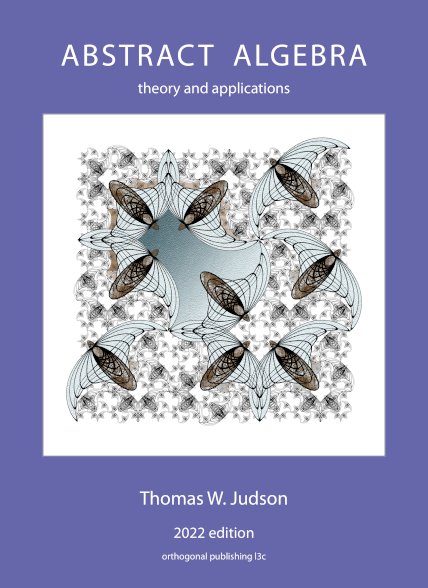Section 14.3 Burnside’s Counting Theorem
Suppose that we wish to color the vertices of a square with two different colors, say black and white. We might suspect that there would be
Burnside’s Counting Theorem offers a method of computing the number of distinguishable ways in which something can be done. In addition to its geometric applications, the theorem has interesting applications to areas in switching theory and chemistry. The proof of Burnside’s Counting Theorem depends on the following lemma.
Proof.
Let
we can define a map
Suppose that
and
Theorem 14.19. Burnside.
Proof.
We look at all the fixed points
However, if viewed in terms of the stabilizer subgroups, this number is
hence,
By Theorem 14.11 and Lagrange’s Theorem, this expression is equal to
Example 14.20.
Subsection A Geometric Example
Before we apply Burnside’s Theorem to switching-theory problems, let us examine the number of ways in which the vertices of a square can be colored black or white. Notice that we can sometimes obtain equivalent colorings by simply applying a rigid motion to the square. For instance, as we have pointed out, if we color one of the vertices black and the remaining three white, it does not matter which vertex was colored black since a rotation will give an equivalent coloring.
The symmetry group of a square,
The group
and
- For
- For
By Burnside’s Theorem, we can conclude that there are exactly
ways to color the vertices of the square.
Proposition 14.21.
Let
Proof.
Let
Since
Suppose that
Example 14.22.
Let
Example 14.23.
Suppose that we wish to color the vertices of a square using four different colors. By Proposition 14.21, we can immediately decide that there are
possible ways.
Subsection Switching Functions
In switching theory we are concerned with the design of electronic circuits with binary inputs and outputs. The simplest of these circuits is a switching function that has
We define a switching or Boolean function of
The possible switching functions with two input variables
For three input variables there are
Consider a switching function with three possible inputs,
Let
Now let us consider a circuit with four input variables and a single output. Suppose that we can permute the leads of any circuit according to the following permutation group:
The permutations of the four possible input variables induce the permutations of the output values in Table 14.27.
Hence, there are
possible switching functions of four variables under this group of permutations. This number will be even smaller if we consider the full symmetric group on four letters.
| Group | Number | |
| Permutation | Switching Function Permutation | of Cycles |
| 16 | ||
| 12 | ||
| 12 | ||
| 6 | ||
| 6 | ||
| 10 | ||
| 10 | ||
| 10 |
Subsection Historical Note
William Burnside was born in London in 1852. He attended Cambridge University from 1871 to 1875 and won the Smith’s Prize in his last year. After his graduation he lectured at Cambridge. He was made a member of the Royal Society in 1893. Burnside wrote approximately 150 papers on topics in applied mathematics, differential geometry, and probability, but his most famous contributions were in group theory. Several of Burnside’s conjectures have stimulated research to this day. One such conjecture was that every group of odd order is solvable; that is, for a group
such that

